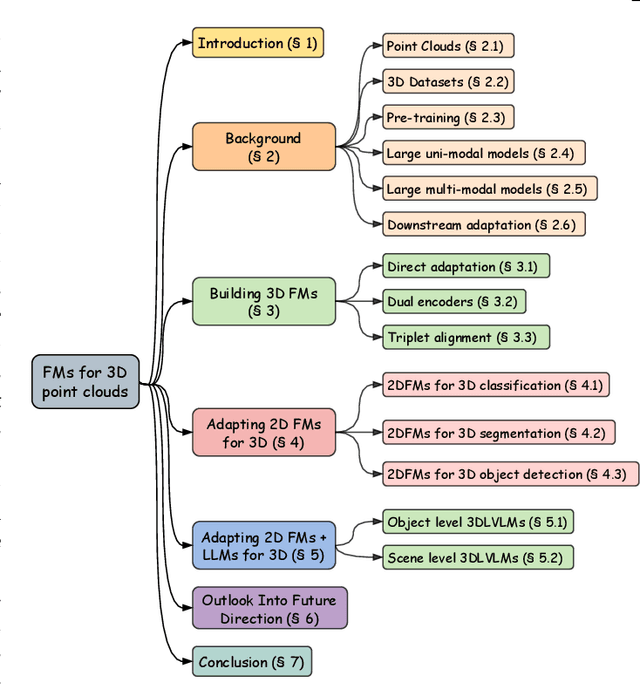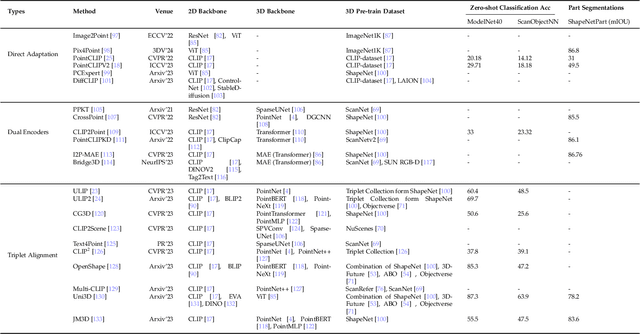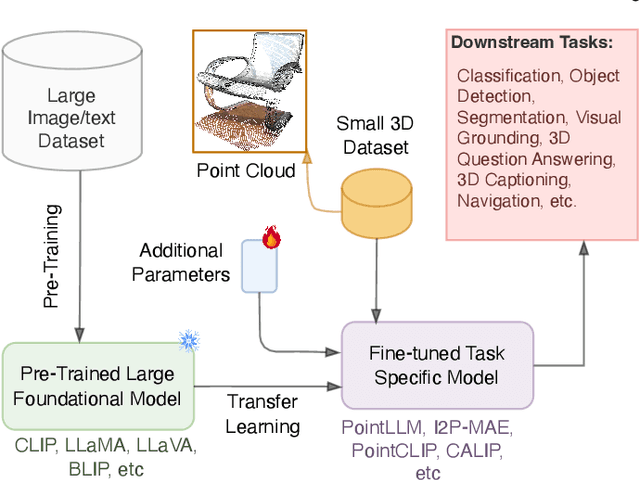Xiatian Zhu
LMAD: Integrated End-to-End Vision-Language Model for Explainable Autonomous Driving
Aug 17, 2025Abstract:Large vision-language models (VLMs) have shown promising capabilities in scene understanding, enhancing the explainability of driving behaviors and interactivity with users. Existing methods primarily fine-tune VLMs on on-board multi-view images and scene reasoning text, but this approach often lacks the holistic and nuanced scene recognition and powerful spatial awareness required for autonomous driving, especially in complex situations. To address this gap, we propose a novel vision-language framework tailored for autonomous driving, called LMAD. Our framework emulates modern end-to-end driving paradigms by incorporating comprehensive scene understanding and a task-specialized structure with VLMs. In particular, we introduce preliminary scene interaction and specialized expert adapters within the same driving task structure, which better align VLMs with autonomous driving scenarios. Furthermore, our approach is designed to be fully compatible with existing VLMs while seamlessly integrating with planning-oriented driving systems. Extensive experiments on the DriveLM and nuScenes-QA datasets demonstrate that LMAD significantly boosts the performance of existing VLMs on driving reasoning tasks,setting a new standard in explainable autonomous driving.
DeMo++: Motion Decoupling for Autonomous Driving
Jul 23, 2025Abstract:Motion forecasting and planning are tasked with estimating the trajectories of traffic agents and the ego vehicle, respectively, to ensure the safety and efficiency of autonomous driving systems in dynamically changing environments. State-of-the-art methods typically adopt a one-query-one-trajectory paradigm, where each query corresponds to a unique trajectory for predicting multi-mode trajectories. While this paradigm can produce diverse motion intentions, it often falls short in modeling the intricate spatiotemporal evolution of trajectories, which can lead to collisions or suboptimal outcomes. To overcome this limitation, we propose DeMo++, a framework that decouples motion estimation into two distinct components: holistic motion intentions to capture the diverse potential directions of movement, and fine spatiotemporal states to track the agent's dynamic progress within the scene and enable a self-refinement capability. Further, we introduce a cross-scene trajectory interaction mechanism to explore the relationships between motions in adjacent scenes. This allows DeMo++ to comprehensively model both the diversity of motion intentions and the spatiotemporal evolution of each trajectory. To effectively implement this framework, we developed a hybrid model combining Attention and Mamba. This architecture leverages the strengths of both mechanisms for efficient scene information aggregation and precise trajectory state sequence modeling. Extensive experiments demonstrate that DeMo++ achieves state-of-the-art performance across various benchmarks, including motion forecasting (Argoverse 2 and nuScenes), motion planning (nuPlan), and end-to-end planning (NAVSIM).
RealEngine: Simulating Autonomous Driving in Realistic Context
May 22, 2025Abstract:Driving simulation plays a crucial role in developing reliable driving agents by providing controlled, evaluative environments. To enable meaningful assessments, a high-quality driving simulator must satisfy several key requirements: multi-modal sensing capabilities (e.g., camera and LiDAR) with realistic scene rendering to minimize observational discrepancies; closed-loop evaluation to support free-form trajectory behaviors; highly diverse traffic scenarios for thorough evaluation; multi-agent cooperation to capture interaction dynamics; and high computational efficiency to ensure affordability and scalability. However, existing simulators and benchmarks fail to comprehensively meet these fundamental criteria. To bridge this gap, this paper introduces RealEngine, a novel driving simulation framework that holistically integrates 3D scene reconstruction and novel view synthesis techniques to achieve realistic and flexible closed-loop simulation in the driving context. By leveraging real-world multi-modal sensor data, RealEngine reconstructs background scenes and foreground traffic participants separately, allowing for highly diverse and realistic traffic scenarios through flexible scene composition. This synergistic fusion of scene reconstruction and view synthesis enables photorealistic rendering across multiple sensor modalities, ensuring both perceptual fidelity and geometric accuracy. Building upon this environment, RealEngine supports three essential driving simulation categories: non-reactive simulation, safety testing, and multi-agent interaction, collectively forming a reliable and comprehensive benchmark for evaluating the real-world performance of driving agents.
CostFilter-AD: Enhancing Anomaly Detection through Matching Cost Filtering
May 02, 2025



Abstract:Unsupervised anomaly detection (UAD) seeks to localize the anomaly mask of an input image with respect to normal samples. Either by reconstructing normal counterparts (reconstruction-based) or by learning an image feature embedding space (embedding-based), existing approaches fundamentally rely on image-level or feature-level matching to derive anomaly scores. Often, such a matching process is inaccurate yet overlooked, leading to sub-optimal detection. To address this issue, we introduce the concept of cost filtering, borrowed from classical matching tasks, such as depth and flow estimation, into the UAD problem. We call this approach {\em CostFilter-AD}. Specifically, we first construct a matching cost volume between the input and normal samples, comprising two spatial dimensions and one matching dimension that encodes potential matches. To refine this, we propose a cost volume filtering network, guided by the input observation as an attention query across multiple feature layers, which effectively suppresses matching noise while preserving edge structures and capturing subtle anomalies. Designed as a generic post-processing plug-in, CostFilter-AD can be integrated with either reconstruction-based or embedding-based methods. Extensive experiments on MVTec-AD and VisA benchmarks validate the generic benefits of CostFilter-AD for both single- and multi-class UAD tasks. Code and models will be released at https://github.com/ZHE-SAPI/CostFilter-AD.
High Dynamic Range Novel View Synthesis with Single Exposure
May 02, 2025Abstract:High Dynamic Range Novel View Synthesis (HDR-NVS) aims to establish a 3D scene HDR model from Low Dynamic Range (LDR) imagery. Typically, multiple-exposure LDR images are employed to capture a wider range of brightness levels in a scene, as a single LDR image cannot represent both the brightest and darkest regions simultaneously. While effective, this multiple-exposure HDR-NVS approach has significant limitations, including susceptibility to motion artifacts (e.g., ghosting and blurring), high capture and storage costs. To overcome these challenges, we introduce, for the first time, the single-exposure HDR-NVS problem, where only single exposure LDR images are available during training. We further introduce a novel approach, Mono-HDR-3D, featuring two dedicated modules formulated by the LDR image formation principles, one for converting LDR colors to HDR counterparts, and the other for transforming HDR images to LDR format so that unsupervised learning is enabled in a closed loop. Designed as a meta-algorithm, our approach can be seamlessly integrated with existing NVS models. Extensive experiments show that Mono-HDR-3D significantly outperforms previous methods. Source code will be released.
Multi-modal Multi-platform Person Re-Identification: Benchmark and Method
Mar 21, 2025Abstract:Conventional person re-identification (ReID) research is often limited to single-modality sensor data from static cameras, which fails to address the complexities of real-world scenarios where multi-modal signals are increasingly prevalent. For instance, consider an urban ReID system integrating stationary RGB cameras, nighttime infrared sensors, and UAVs equipped with dynamic tracking capabilities. Such systems face significant challenges due to variations in camera perspectives, lighting conditions, and sensor modalities, hindering effective person ReID. To address these challenges, we introduce the MP-ReID benchmark, a novel dataset designed specifically for multi-modality and multi-platform ReID. This benchmark uniquely compiles data from 1,930 identities across diverse modalities, including RGB, infrared, and thermal imaging, captured by both UAVs and ground-based cameras in indoor and outdoor environments. Building on this benchmark, we introduce Uni-Prompt ReID, a framework with specific-designed prompts, tailored for cross-modality and cross-platform scenarios. Our method consistently outperforms state-of-the-art approaches, establishing a robust foundation for future research in complex and dynamic ReID environments. Our dataset are available at:https://mp-reid.github.io/.
Bayesian Test-Time Adaptation for Vision-Language Models
Mar 12, 2025Abstract:Test-time adaptation with pre-trained vision-language models, such as CLIP, aims to adapt the model to new, potentially out-of-distribution test data. Existing methods calculate the similarity between visual embedding and learnable class embeddings, which are initialized by text embeddings, for zero-shot image classification. In this work, we first analyze this process based on Bayes theorem, and observe that the core factors influencing the final prediction are the likelihood and the prior. However, existing methods essentially focus on adapting class embeddings to adapt likelihood, but they often ignore the importance of prior. To address this gap, we propose a novel approach, \textbf{B}ayesian \textbf{C}lass \textbf{A}daptation (BCA), which in addition to continuously updating class embeddings to adapt likelihood, also uses the posterior of incoming samples to continuously update the prior for each class embedding. This dual updating mechanism allows the model to better adapt to distribution shifts and achieve higher prediction accuracy. Our method not only surpasses existing approaches in terms of performance metrics but also maintains superior inference rates and memory usage, making it highly efficient and practical for real-world applications.
CLIMB-3D: Continual Learning for Imbalanced 3D Instance Segmentation
Feb 24, 2025Abstract:While 3D instance segmentation has made significant progress, current methods struggle to address realistic scenarios where new categories emerge over time with natural class imbalance. This limitation stems from existing datasets, which typically feature few well-balanced classes. Although few datasets include unbalanced class annotations, they lack the diverse incremental scenarios necessary for evaluating methods under incremental settings. Addressing these challenges requires frameworks that handle both incremental learning and class imbalance. However, existing methods for 3D incremental segmentation rely heavily on large exemplar replay, focusing only on incremental learning while neglecting class imbalance. Moreover, frequency-based tuning for balanced learning is impractical in these setups due to the lack of prior class statistics. To overcome these limitations, we propose a framework to tackle both \textbf{C}ontinual \textbf{L}earning and class \textbf{Imb}alance for \textbf{3D} instance segmentation (\textbf{CLIMB-3D}). Our proposed approach combines Exemplar Replay (ER), Knowledge Distillation (KD), and a novel Imbalance Correction (IC) module. Unlike prior methods, our framework minimizes ER usage, with KD preventing forgetting and supporting the IC module in compiling past class statistics to balance learning of rare classes during incremental updates. To evaluate our framework, we design three incremental scenarios based on class frequency, semantic similarity, and random grouping that aim to mirror real-world dynamics in 3D environments. Experimental results show that our proposed framework achieves state-of-the-art performance, with an increase of up to 16.76\% in mAP compared to the baseline. Code will be available at: \href{https://github.com/vgthengane/CLIMB3D}{https://github.com/vgthengane/CLIMB3D}
Foundational Models for 3D Point Clouds: A Survey and Outlook
Jan 30, 2025



Abstract:The 3D point cloud representation plays a crucial role in preserving the geometric fidelity of the physical world, enabling more accurate complex 3D environments. While humans naturally comprehend the intricate relationships between objects and variations through a multisensory system, artificial intelligence (AI) systems have yet to fully replicate this capacity. To bridge this gap, it becomes essential to incorporate multiple modalities. Models that can seamlessly integrate and reason across these modalities are known as foundation models (FMs). The development of FMs for 2D modalities, such as images and text, has seen significant progress, driven by the abundant availability of large-scale datasets. However, the 3D domain has lagged due to the scarcity of labelled data and high computational overheads. In response, recent research has begun to explore the potential of applying FMs to 3D tasks, overcoming these challenges by leveraging existing 2D knowledge. Additionally, language, with its capacity for abstract reasoning and description of the environment, offers a promising avenue for enhancing 3D understanding through large pre-trained language models (LLMs). Despite the rapid development and adoption of FMs for 3D vision tasks in recent years, there remains a gap in comprehensive and in-depth literature reviews. This article aims to address this gap by presenting a comprehensive overview of the state-of-the-art methods that utilize FMs for 3D visual understanding. We start by reviewing various strategies employed in the building of various 3D FMs. Then we categorize and summarize use of different FMs for tasks such as perception tasks. Finally, the article offers insights into future directions for research and development in this field. To help reader, we have curated list of relevant papers on the topic: https://github.com/vgthengane/Awesome-FMs-in-3D.
Sebra: Debiasing Through Self-Guided Bias Ranking
Jan 30, 2025



Abstract:Ranking samples by fine-grained estimates of spuriosity (the degree to which spurious cues are present) has recently been shown to significantly benefit bias mitigation, over the traditional binary biased-\textit{vs}-unbiased partitioning of train sets. However, this spuriosity ranking comes with the requirement of human supervision. In this paper, we propose a debiasing framework based on our novel \ul{Se}lf-Guided \ul{B}ias \ul{Ra}nking (\emph{Sebra}), that mitigates biases (spurious correlations) via an automatic ranking of data points by spuriosity within their respective classes. Sebra leverages a key local symmetry in Empirical Risk Minimization (ERM) training -- the ease of learning a sample via ERM inversely correlates with its spuriousity; the fewer spurious correlations a sample exhibits, the harder it is to learn, and vice versa. However, globally across iterations, ERM tends to deviate from this symmetry. Sebra dynamically steers ERM to correct this deviation, facilitating the sequential learning of attributes in increasing order of difficulty, \ie, decreasing order of spuriosity. As a result, the sequence in which Sebra learns samples naturally provides spuriousity rankings. We use the resulting fine-grained bias characterization in a contrastive learning framework to mitigate biases from multiple sources. Extensive experiments show that Sebra consistently outperforms previous state-of-the-art unsupervised debiasing techniques across multiple standard benchmarks, including UrbanCars, BAR, CelebA, and ImageNet-1K. Code, pre-trained models, and training logs are available at https://kadarsh22.github.io/sebra_iclr25/.
 Add to Chrome
Add to Chrome Add to Firefox
Add to Firefox Add to Edge
Add to Edge